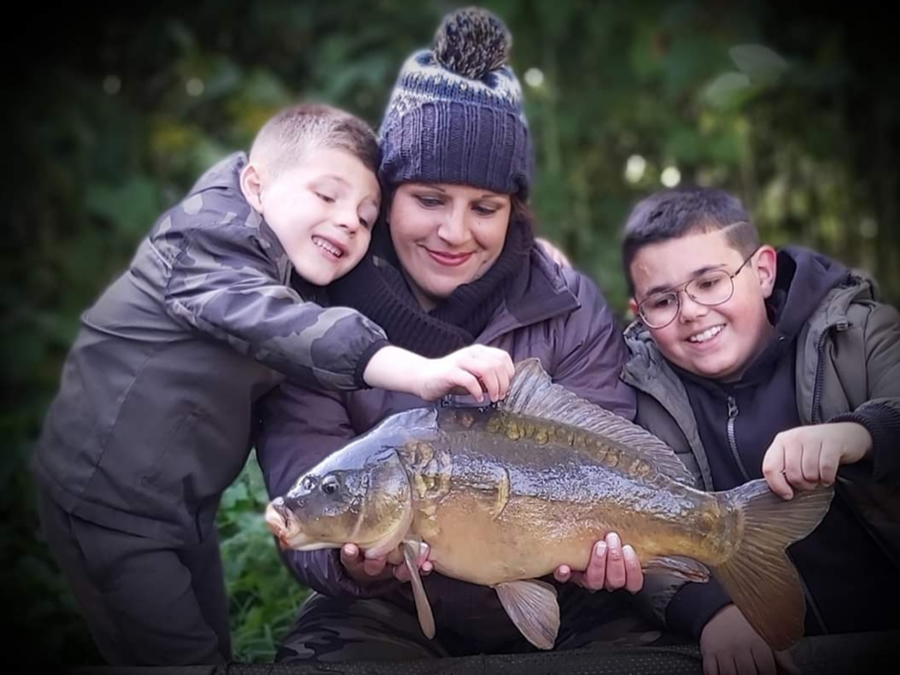Award-winning projects 2018-19
Fifty-eight new angling projects were selected for funding from the Angling Improvement Fund during 2018-19 – with the total value of all the projects worth over £760,000.
In addition to the £296,000 awarded by the AIF, the winning applicants also contributed £280,000 themselves plus an estimated £187,000 of volunteer time.
Funding was split into four distinct but different themes:
General Maintenance
This popular theme was aimed at small scale, quick-to-deliver projects that assisted with the upkeep of venues that are popular with anglers and attracted 51 applications from a variety of organisations. Funding was provided to repair and/or upgrade swims, improve footpaths, car parking areas, toilet facilities, tree work and the installation of notice boards. In total just over £102,000 was invested in 23 winning projects that had an estimated value of almost £250,000.
Tacking Predation
Once again, this ever-present theme of tacking predation by fish eating birds and otters at venues throughout the country was as popular as ever with 29 applications being received. Grants towards this purpose are always part of the AIF and offer help to support non-lethal methods to protect fish stocks. In 2018-19, the AIF approved 12 projects and awarded £97,000 of rod licence income, including nine requests to help with the installation of an otter proof fence.
Access to Rivers
Funding towards improvements to enable anglers to safely navigate their way along the riverbank and the creation of new angling platforms was the focus of this theme. Organisations could apply for up to £5,000 and 11 of the 16 applications received were approved with grants totalling £48,000.
Access for All
In this theme the AIF looked to provide funding for infrastructure projects that would specifically aid facilities for disabled anglers and encourage junior participation. The AIF received 25 applications worth over £270,000 and 12 projects were eventually approved. Between them they received funding totalling almost £49,000 with most of the money being spent on improvements to pathways and new fishing platforms.
Here’s some of the AIF-funded projects in 2018-19:
North East:
Easington District Angling Society
Easington District Angling Society was founded in 1976, originally named Peterlee Angling Club. The name was changed in 1979 to secure funding enabling the purchase of Wellfield Lake, located at Moor Lane in the small pit village of Wingate Nr Durham.
The lake stands within 8 acres of land and enables fishing in over 3.5 acres of water and circa 30 pegs, including disabled pegs. Fishing is mixed, with Carp, Bream, Tench, Perch, Roach, Rudd, Crucian Carp, Gudgeon & Ide all available at the lake.
Funding was provided to purchase the materials needed for the new pathway around the lake and car parking facility. Volunteers from the club assisted the chosen contractor to undertake the work. As part of the project the club requested an access audit to be undertaken by the BDAA (British Disabled Angling association) which proved to be invaluable with lots of help and recommendations which has assisted the club with ways to provide betters access for less able-bodied anglers in mind.
Since the award from the AIF the club have secured further funding from other sources and undertaken additional improvements to enhance this venue.
The Carrs Angling Lakes

Located on the edge of the village of Carlton near Stockton-on-Tees in the North West of England, this well stocked 4 pool fishery applied to the AIF for funding under the ‘General Maintenance’ theme towards the resurfacing of a very poor section of circa 200 metres of access road into the fishery.
The road had originally been built on low lying ground with poor drainage and therefore prone the wet weather. Funding was awarded to assist the fishery to creating a hardwearing surface for anglers to access the venue.
The fishery was been offering high quality angling facilities since 2005 and have further plans to open a new three-acre specimen lake in 2020. The existing lakes are well stocked with a variety of fish including a ‘silver lakes’ for those anglers not interested in catching just carp.
The fishery is already fenced with an otter proof fence and good car parking for visiting anglers, toilet facility and tackle shop. The goal of this fishery is to be the number one still water for recreational coarse fishing in the Tees Valley and northeast area.
North West:
Ridgehill Big Local Enterprise
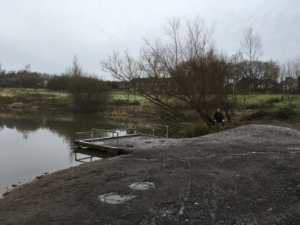
Ridgehill Big Local Enterprises (RBLE) is a not for profit business that holds a 25-year lease for Stamford Park Boating and fishing lake and Chadwick Dam fishing lake, next to Tameside hospital near Stalybridge in Greater Manchester.
Residing within an area of low social-economic background, access to activities which are of social and health benefit within the local area are of great importance to the community. The community within the lake area suffered from youth anti-social behaviour and community isolation and struggled to afford activities which prevented them from the anti-social behaviour that is associated with young people gathering on community streets.
In 2017 they created a new angling club aimed at offering angling at this venue for young people to attend with their families. With the help of a separate AIF coaching grant, two local people successfully attended a Level 1 coaching course and began to offer various family fishing day events at the Dam. These proved to be very successful hence they applied for a further grant under the ‘Access for All’ theme to install various new fishing platforms and a third grant for some materials to make fish refuges to protect the newly introduced fish from predation by cormorants etc.
Through these events, RBLE hope to inspire a passion for angling in local young people promoting the new youth angling club to themselves and their families and to plant a seed of inspiration in other young people in the area.
Wyreside Lakes

Wyreside Lakes is a family run business, situated in over 120 acres of farmland at the foot of the Bowland Fells in Dolphinholme, Lancashire. The owners are tenants of the Duchy of Lancaster and via the estate offer 6 fishing lakes – with a superb stocking of both coarse fish and pike.
Over the last 26 years the estate has been transformed and now not only appeals to fishermen but also to families and couples alike who wish to have a relaxing break in a beautiful setting without having to travel long distances to Britain’s national parks.
Wyreside is a development on an expired gravel quarry and as such has varying degrees of ground quality around the site. An application was submitted to the Angling Improvement Fund under the Fish Protection & Predation Management theme, to assist with the construction of a very long fence around the venue, circa 3,500 metres of fencing was needed.
The work was undertaken by a local fencing contractor who helped the owners to plan the work and to have it completed to a high standard that will protect the valuable fish stocks for many years to come.
Ramsbottom Angling Association
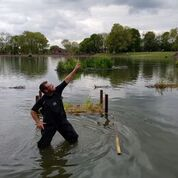
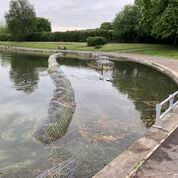
This long-established northern club lease Clarence Park Lido from Bury Council and it’s been the base for their clubhouse and excellent coaching programme for the past two and a half years.
As with most lido’s around the country the Bury lido is a concrete bowl with concrete sides and formal footpaths and parkland around the water. This creates a problem when looking to add structures and planting to the water as there is no way of securing the structures to the margins. There was a small island added to the water, but this was reduced by the angling club as it had become a loafing sight for cormorants that were then feeding on the waters fish population.
A netting survey by the EA identified some mature fish, carp and tench, but limited silvers which had been previously stocked in the water. An IFM advisory report was commissioned and recommended developing the work already started by the club i.e. the installation of floating islands, with the planting of new marginal habitat as a way forward to give the fish place to both hide and spawn.
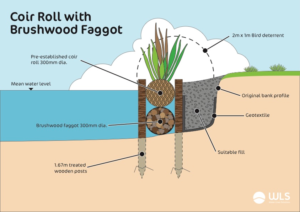
Funding from the AIF was sought to purchase pre-plated coir rolls
which were secured by brackets drilled into the concrete bank, the rolls were then fully submerged and provide a nice dense margin. In total almost 100 meters of these rolls were purchased.
RAA have a very active junior section and used the fishery for its weekly coaching sessions, and has it’s teaching centre on the banks, hence it was important that the water was returned to a sustainable fishery as quickly as possible. In addition to the above funding RAA also sough funding for a new metal container in which to store their ever-increasing tackle supply needed at the ongoing coaching sessions.
South East:
Acorn Community Centre

The Billy’s Lake Project was led by the Community Conservation officer based at Acorns Community Centre with input from a local fishing club for disabled anglers. Together They wanted to improve access to this free public fishing lake and to encourage those in wheelchairs or with mobility impairments to take up angling as a sport by installing an accessible path around the lake edge together with two new fishing platforms suitable for disabled anglers.
Fishing at this venue in Denmead, Hants is free but not very accessible to people with impaired mobility due to the gradient, width and condition of the ground particularly during the winter months. Advice was sought from the Sensory Trust for details on minimum and maximum widths, gradients, cambers etc for wheelchairs, and from the British Disabled Angling Association for additional information on paths and fishing platforms.
In 2017 a footpath was installed from the car park to the top of the lake suitable for wheelchairs but unfortunately the path ended before reaching the lake therefore disabled people still couldn’t access or fish the lake. Hence, further improvements were needed to allow disabled anglers to access some of the fishing swims around the lake.
Funding from the AIF and the EA was given towards the purchase of the necessary materials to complete the project with the work being carried out by volunteers from the local community and fishing club.
The centre offers regular fishing workshops for junior anglers during school holidays at the lake. The workshops are aimed at encouraging children who’ve never fished before to give it a go, and to also welcome children who fish regularly and need advice and support on improving their technique/equipment etc.
The aim of the project was to create a safe and accessible environment for junior and adult disabled anglers and to help reduce feelings of isolation in the community by providing free and safe access to the sport of angling.
Letchworth Garden City Angling Association
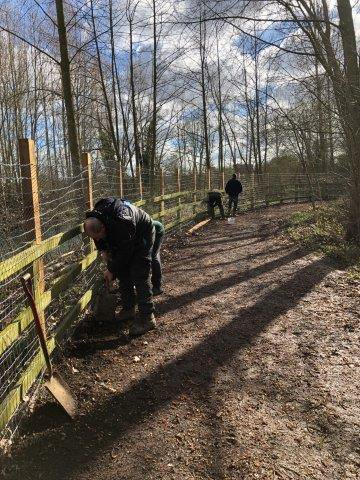
Installing an otter fence at Poppy Hill lakes near Henlow in Bedfordshire has been top of the club’s priority list for quite a while following various reports from members saying that they had observed otters at the complex.
Knowledge and proof of otter predation lower down the nearby River Ivel is well documented and there have been accurately reported incidents of otters working their way up the river causing other nearby fisheries and landowners to take their own protection measures.
The Association has around 300 members and offers open unlimited membership to anyone wishing to join. The venue is a mixed coarse fishery with all lakes well stocked with a mixture of fish and sizes.
Funding received from the AIF, together with a large cash donation from the club, was used for the sole purpose of assisting with the purchase costs of the fencing materials required and the appointment of specialist contractors to undertake the actual installation works. The club felt that some of the work needed would be beyond their volunteer skillsets, although they would be used to clear the site and undertake other jobs once the contractor had done the heavy work.
The Association own the venue, hence regular work parties are arranged via a dedicated fisheries management team. This same team will be undertaking regular inspections, maintenance and all repair works to the new fence thereby ensuring total protection for years to come.
Ashford Angling Society
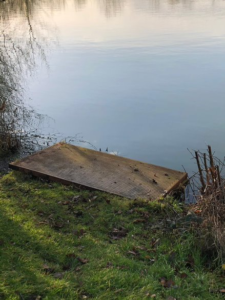
Old Peg

New Peg
Ashford Angling Society was established in 1902 and owns and leases waters on behalf of its 500 plus members.
The main waters which the society own are Surrenden Complex, Bethersden, Nr Ashford with beautiful views across the weald to the North Downs, which the club describes as being ‘a truly magnificent 3 lake complex which provides members with a safe and secure place to fish’.
Being a previous recipient of AIF funding, the club successfully applied for two separate grants both under the ‘General Maintenance’ theme. The first award was given towards a project that aimed at making some of the fishing pegs safer and easier to access. They currently have circa 150 pegs made from metal platforms that protrude over the water and had already begun making improvements as part of their 5-year plan. The new pegs were installed using volunteers and are encased in plastic to help prevent slips., and following a request from the clubs’ lady chairperson, several larger pegs were also installed to accommodate and promote family fishing.
The second award was aimed at reinstating an old overgrown stagnant pond on the same complex with the idea of bringing it back to life and turning it into a crucian carp pool. In addition, new car parking was needed together with pathways to ensure safe access to the waterside. By completing this project, the club was able to offer its members a more traditional angling experience whilst establishing a true Crucian Carp colony.
Since completing the above the club has recently installed a new security system at the fishery which is card access, allowing them to monitor members’ activity in detail.
Shamley Green Angling Society
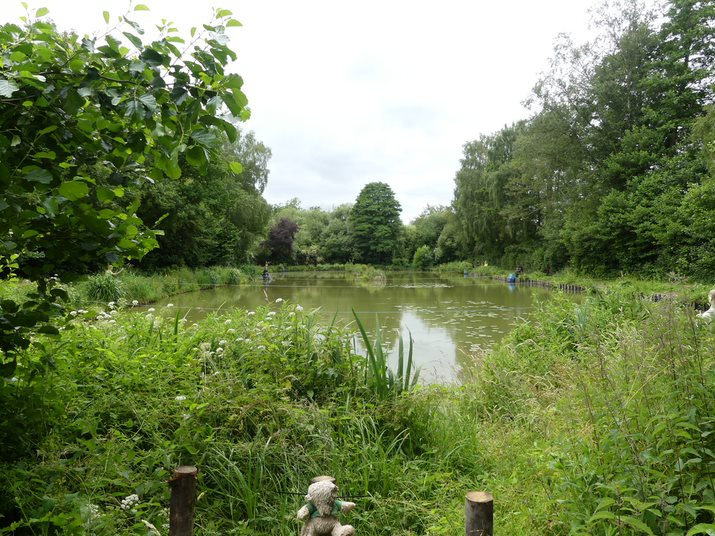


Funding from the Angling Improvement Fund was secured by this Surrey based club to assist with the continuation of urgent ongoing essential maintenance and repair works to the bankside of the societies principal water, Barrett Pond at Shamley Green.
The project was necessary to halt further bank side erosion and deterioration along a 40m stretch of the pond. The lack of suitable club funding meant that this essential repair work had already been delayed longer than the society would have preferred. Apart from undercutting the fishing swims, the bank erosion narrowed the access track in places, and threatened the integrity of the fishery because of the risk of a breach into the streams on either side.
The project was managed by Aquascience Ltd, under the supervision of the Society’s committee, with club volunteers assisting in clearing the site and preparing it for the arrival of the contractor’s plant and equipment. Aquascience had previously done similar work to another section of the same pond during the previous season. The new work also included the restoration of some swims/pegs and included the need to purchase 60 tonnes of hardcore, excavation of various tree stumps and the re-instatement of pegs with additional posts and gravel boards.
Following completion of the project the society said that “in our opinion, this project has been a good use of Rod/Fishing Licence income”.
South West:
Alcove Angling Club
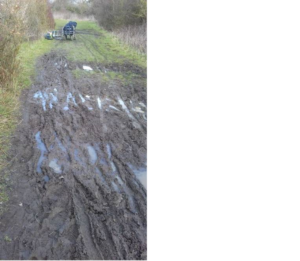
Before the works
The Alcove Angling Club was established in 1962 for the furtherance of the interest of local angling and to provide coarse fishing for its members. The club owns one lake and leases three others including two at Whitehouse Farm, Earthcott, near Bristol. They are all stocked with a good mixture of coarse fish.
The club successfully applied for a grant under the ‘Access for All’ theme towards a project aimed at repairing the 150-meter pathway running between the two lakes at Whitehouse Farm. Access along this track had become difficult to negotiate for most members with many deep potholes and, in wet conditions, mud up to ankle depth!
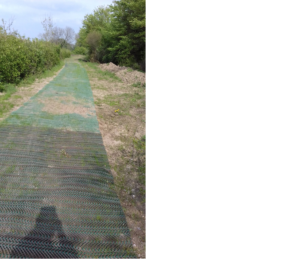
After
The base was found to be red clay and impervious to water, which did not allow excess water to drain easily. A more robust drainage system using perforated pipe, as well as mesh plus increased amounts of pea gravel/scalping’s and topsoil was therefore implemented. An original excavation and drainage installation utilised some of the red clay as back filling, but this proved ineffective, hence a re-excavation had to take place replacing the red clay with more pea gravel and scalping’s. This was obviously far more expensive in both excavation and material costs, but a far better outcome was achieved.
The work was undertaken by club volunteers over the cold and wet winter months, but the new path is clearly much better than the old muddy one and once the grass begins to grow through the plastic mesh a firm and even pathway will be much appreciated by visiting anglers for many years to come.
Park Gate Royal Legion Angling Club

This Hampshire based angling club was originally formed by a group of local anglers who approached the Sussex and Dorking Brick Company (Redland Brick) in the late 1950’s in order to gain permission to fish the clay pits that were no longer being excavated.
In 2005 the brickworks site was sold in order to build a new Air Traffic Control Centre (NATS). Although fishing continued at the lakes, the overall management of the site passed to the Hampshire and Isle of Wight Naturalist Trust (HIOWT). Fishing on two lakes was lost, one was within the security perimeter of the Air traffic control Centre and one was backfilled and became part of the Naturalists Centre. However, the three ‘newest’ lakes that had stopped being excavated in the 1970’s were retained and are now known as Swanwick Lakes, Nr Southampton. The lakes were simply holes in the ground surrounded by bare clay which has historically caused problems with even a small amount of rain creating very muddy conditions and difficult to access pathways. Some of the swims become waterlogged and makes fishing from them very difficult.
The successful grant application secured funding from the AIF to be spent on acquiring plastic ground reinforcement grids which were used to stabilise the pathways and provide a firmer surface. This meant more of the fishery became accessible, especially during wet weather, and the swims would be more comfortable to fish from rather than the anglers sinking into the mud.
Sturminster & Hinton Angling Association
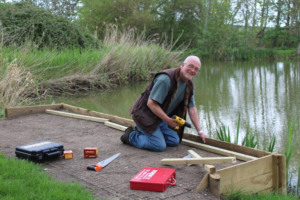
For over 110 years the Dorset based Sturminster and Hinton Angling Association has been providing excellent river fishing on the middle reaches of the famous Dorset Stour.
Whilst the river remains a popular place for its members and visitors to fish, the club were keen to offer alternative still water fishing as part of its membership package. The club rents Mappowder Court Lakes and applied to the Angling Improvement Fund (AIF) seeking a grant, under the ‘General Maintenance’ theme, towards opening two unfishable waters which the EA Wessex region were keen to use as a venue as part of their efforts to reintroduce indigenous pure-bred crucian carp to English waters. Other work at the venue included improvements to circa 150 metres of access track plus several new safe fishing platforms were installed by club volunteers based on previously tried and tested examples from previous work parties, with the help of a contractor to undertake the heavier work.
The funding provided by the AIF was matched by the club with its own cash and volunteer time contribution.
Yorkshire & Humber:
Tolson Angling Club
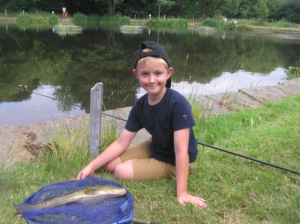
This small but dynamic club asked for some funding to install an additional three new fish refuges at the Tolson dams near Huddersfield.
Run by an enthusiastic and dedicated angler this lovely fishery tries hard to make these pools into a place people just want to visit and take-in the wonderful bird and insect life whilst enjoying their time fishing.
Funding was provided to assist the club to protect its fish stocks from predation
York & District Amalgamation of Anglers
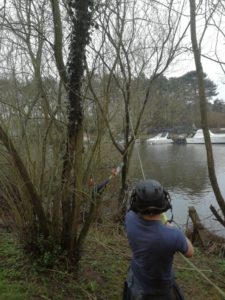

The YDAA was started in 1887 and now encompasses ten individual clubs and has over a thousand members. They provide a wide range of angling opportunities including access to over twenty stretches of prime Yorkshire river fishing. The club operates an open and unlimited membership as well as day and season tickets.
As part of its strategic fishery management plan, the club was trying to improve access to all river venues, some of which had become underused due to lack of access and overgrown banks.
One of the funding applications approved by the AIF was to enhance the access to several swims along a popular stretch of the Yorkshire Ouse river known as the Donkey Woods and Captains Keys venue just south of the city of York. The River once held large matches of over 200 pegs but had now limited access to around 70 accessible pegs. Funding was provided towards the costs of pollarding the trees whilst the club contributed towards the purchase of other materials needed to complete this work.
A separate award was granted to this club under the ‘General Maintenance’ theme to assist them with improvements at Laybourne Lakes near Hessay. In order to cater for an ageing membership, the club wanted to provide a toilet facility at this busy venue. A large refurbished construction site welfare unit with toilet and generator was purchased that would provide visiting anglers with such a facility and an inside room with heating, first aid point, water and ability to cook hot food. A self-contained generator is on site to power everything including previously purchased aerators that help to keep the water well oxygenated. Additional work was undertaken to improve the large car park facility plus pathways leading to the pegs around the complex.
East Midlands:
Ashby Angling Club

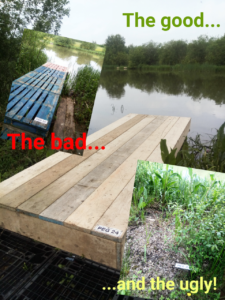
Spring Wood Lake near Ashby De La Zouch is quirky, naturally beautiful, provides easy fishing and has some fantastic potential, but is the clubs least access-friendly water was sadly in some need of some TLC.
A newly shaped club-committee had brought with it new ideas, new enthusiasm and a real drive to turn the club around and sought some financial help from the Angling Improvement Fund to keep the momentum going. The club said that “the volunteers and enthusiasm is there – the funds, not so much”.
Their project had four elements;
1) Repair a dirt track leading up to the lake (they described some pot holes big enough to be stock ponds!!)
2) Creation of a parking/drop off area round the back of the lake which will make accessing some of the pegs much easier
3) Install a secure shed/store to keep essential ongoing maintenance tools much easier
4) Refitting/repairing of some of the 25 pegs around the lake
By re-doing the older pegs first and by putting a second gate in at the bottom/back end of the lake it quickly encouraged more anglers to visit the water.
The club was able to contribute some funds towards the materials but the real asset they had was its plenty of volunteers, skilled labourers and some good old-fashioned enthusiasm, and with the assistance of a small grant achieve the all the above.
Following the completion of the project the club reported that the had already seen a definite increase in membership and had received positive comments to the improvements made. The club said that “With the financial help provided by the Angling Improvement fund we have been able to turn a somewhat neglected venue into something that is now much safer, aesthetically pleasing, and much easier to access for both existing and new members alike.
Thank-you again – it’s genuinely made a massive difference in the fortunes of the club. Awarding us this grant has made some of the “old boys” who have fished the water for 20+ years incredibly happy as apparently, it’s never looked better. Thank you”.
Long Eaton Victoria Angling Society
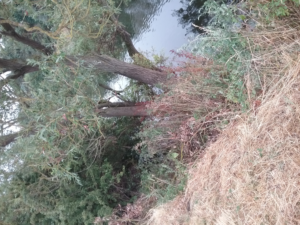
Before
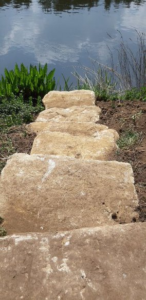
After
Long Eaton Victoria Angling Society was formed way back in 1880 by a group of regulars at the Victoria Inn who each agreed to contribute one old penny per week on top of an annual subscription. The principal activity of the Society was for members competing to catch the biggest fish of each nominated species.
Funding was sought from the AIF to help with the installation of some new pegs along the banks of the mighty River Trent at Cranfleet Lock which the Society have had the fishing rights on for the past 106 years. Over time the number of swims on this section of river has decreased due to trees closing them up despite some routine attention by club volunteers. Work to remedy the problem had been on hold for the previous two years due the land being sold to new owners and their resultant legal complexities. The reduction in the number of swims had impacted on membership numbers and the height of the bank made it virtually impossible for members to safely access swims down to the water’s edge.
The first part of the project involved some significant tree clearance work and management by professionals. The second stage involved the installation of stone and/or concrete steps along the sections where the bank was around 3 metres high. In total 6 new swims were created, with the added benefit of providing a better and safer access for anglers with certain disabilities.
It is the intention that now this work is completed the Society will look at creating a secure car parking area which will also reduce the walking distance to the new swims and again prove an attraction to new members.
NCB Area No.5 Angling Club
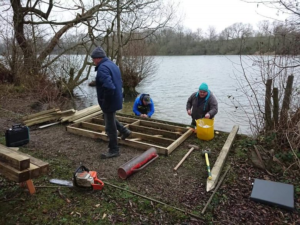
Both projects were necessary due to the financial cut backs made by the local authority to Shipley Country Parks budget resulting in the onus being put back onto the fishing club to maintain and improve the waters.
Firstly, funding was provided under the ‘Access for All’ theme to assist the club to make the pathways safer to use for anglers of all abilities to acess the bank side swims. Many of the pegs and paths had become unusable and impassable and unsafe to fish from on the grounds of health and safety.
The second grant was given under the ‘General Maintenance’ theme and used towards the rebuilding and installation of new fishing platforms at both waters plus tree and marginal work. The work was undertaken my members of the club during the winter months.
East of England:

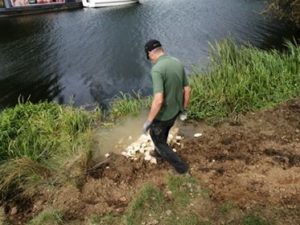
P&DAA own the fishing rights to this renowned good mixed fishery where in the winter sees many species of fish shoal up in the deeper water. The surrounding meadows are grazed by a tenant farmer and over the years the banks had become poached by cattle making them very difficult to access. Additionally, anglers had been deterred from fishing there due to the presence of the livestock.
The Association applied for AIF funding under the ‘Access to Rivers’ theme to assist them with a project to develop this area into an all year-round match venue and additionally offer access to pleasure anglers and junior participants who could be coached in the art of river fishing. To achieve this an area of approximately 500 metres of bankside needed to be fenced to prevent livestock causing further damage and to allow anglers to fish without interference from grazing animals.
During the discussions with the landowner P&DAA were able to engage with them and managed to virtually triple the amount of fencing installed, 1,471 metres, almost three times longer than originally planned, a great achievement.
Now this part of the project is complete P&DAA intend to install new fishing platforms to assist anglers to fish the water more effectively, thus increasing the number of anglers making river fishing visits all year round.
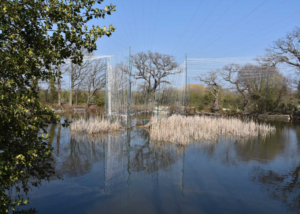
The Post Office Angling Society (POAS) was established over 40 years ago by a group of post office telephone engineers (hence the title) and is now a family-oriented club based near Southend in Essex. They encourage members to bring their family and do not charge for the guests and now have a steady membership of around 220 members.
Cormorant predation in the and winter months had been particularly bad over the last few years with catches of silver fish at their Lambourn venue declining from around an average of 30lbs to 3lbs per angler. The club believed that the increase in cormorant activity was due to the recently constructed nature reserve the “Wallasea Island Coastal Project”, which is only a couple of miles from the lakes. Also, a neighbouring fishing club with several waters had been netting and removing what silver fish were left and replacing them with large carp, which are much less prone to cormorant predation, hence the cormorants were now targeting their water harder than in the past.
The club had experienced the same issue at its other venue and tried low level ropes, fish sanctuaries etc to deter the birds but still lost most of the stocking to the cormorants. They decided that the only option to fully deter them was to erect high-level ropes at 1 metre intervals, and since doing so had not seen any sign of further cormorant predation and the fishing improved dramatically.
Based upon this knowledge they applied to the Angling Improvement Fund for a small grant to erect similar high-level ropes over the small lake at Lambourne, with rope curtains where necessary.
The club had numerous members volunteering their time to work on this project, even some saying they would take holidays from work just to get the project completed such was the enthusiasm.
Afterwards the club said that “without this funding we would not have been able to undertake the project for a number of years, by which time our fish stocks would have been significantly depleted by predation and wanted to thank the AT and EA for assisting them”.
Somersham Angling Club

Before
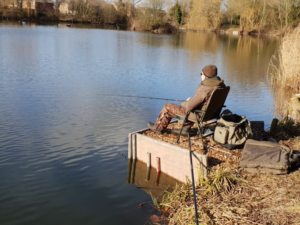
After
The fishery had been neglected for several years with only essential maintenance being carried out by a team of volunteers from the nature reserve group. Following the formation of the new angling club, they quickly joined forces with the Nature Reserve Friends Group to produce a long-term plan. A survey undertaken by the nature reserve group proved that there was great support for improving the lake as a fishery.
Funding was sought under the ‘General Maintenance’ theme towards help with the purchase and construction of a Family/Disabled fishing platform, construction and repair of a pathway, the purchase of floating vegetated islands, coppicing of bankside trees and the purchase of native wildflower plant plugs.
The club stated that they ideally wanted to complete this work before starting its campaign to encourage more people to have a go at angling. The nature reserve and lake are a much-loved community asset but the fishing aspect had declined and so they wanted to carry out this work to encourage more anglers to join in again. All works followed recognised designs and specifications provided by the British Disabled Anglers Association and the Paths for All design codes.
The work was completed through a combination of volunteer effort and use of contractors for the heavier work (trees and peg construction). Somersham Angling Clubs funding from the Parish Council and the Environment Agency which together with the Angling Trust grant has transformed an overgrown tired lake back into a hub for the local community. This project has inspired new and old anglers onto the bank giving them a safer and more pleasant environment to fish in.
The Parish Council were fully supportive of the project and providing some matched funding for an aeration pump to help improve the quality of the water.
West Midlands:
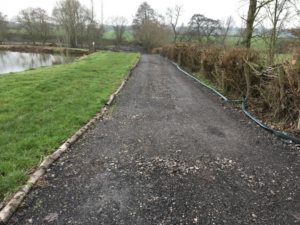
Having taken advice from the British Disabled Angling Association (BDAA) and listened to visiting anglers, the owners successfully applied for two separate grants under the ‘Access for All’ and ‘General Maintenance’ themes.
To celebrate the opening of the new facilities the fishery held an open day which included free coaching sessions and attracted over 50 participants.

Their project was aimed at reclaiming and managing an overgrown stretch of land belonging to the Town Council at the Sports Club site of the River. The proposal was to create an area of beauty with a level pathway along the length of the bank to enable the general public to access this whilst opening the area for recreation and safer fishing tuition. Steps would lead from the path, at intervals, down to the river’s edge. The soil removed during the project was used to make the area level and to also build a soil ‘bund’ for additional seating at the side of the football pitch.
Where the river had been eroded the existing bank was reinforced with interwoven natural willow branches into wooden stakes to prevent further erosion. Overgrown trees were respectfully pollarded / trimmed, and flora and fauna returned to an acceptable and manageable state.
Every year the club host a three-day fishing competition, known as ‘Fish & Frolics’ complete with live music, free fishing for the children, camping, pig roast and games.
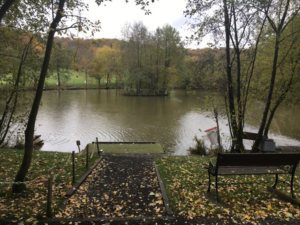
Circa 20 pegs are available with adequate car parking and the benefit of an on-site angler’s lodge with plenty of good fish to be caught.
A small grant from the AIF was used to install a new aerator, improve the surrounding fence and to purchase some equipment for visiting anglers to use.
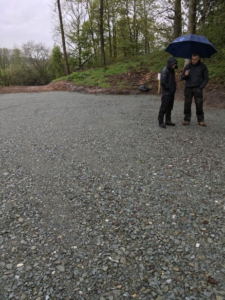
Having secured a previous award from the AIF in 2017, which enabled them to develop 2 new 40-metre-long access walkways through steep sided woodland to the riverside, the club subsequently had an influx of new members.
This new award allowed the club to make further improvements to other paths and enhanced the car parking facility. New signage and display boards were purchased together with new gates and fencing (not otter fencing). In addition, some tree work and vegetation clearance around pegs/swims and approaches were completed to attract anglers to the riverbank.
To celebrate the completion of the work an opening event was organised to publicise the opening of a car park. The local Member of Parliament for Shrewsbury ‘Daniel Kawcyznski’ came and performed a ‘Ribbon Cutting’ ceremony and the club did a live broadcast on the BBC Shropshire radio station to talk about this and its other efforts to get anglers back to river fishing.
Shrewsbury Town Fisheries

Shrewsbury Town Fisheries is responsible for operating all aspects of coarse and game angling on still and running water owned by Shrewsbury Town Council.
This project involved the construction of some additional new permanent peg structures that did not protrude into the popular River Severn in the town centre, providing both pleasure and match anglers with safe access to fish.
This is part of a much bigger project which is to revamp all Shrewsbury Town Fisheries’ venues over the next three years, including two pools where they are also looking to improve coaching facilities.


